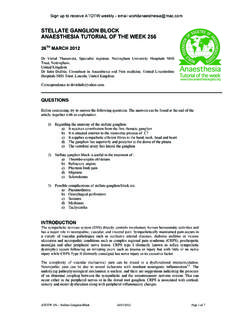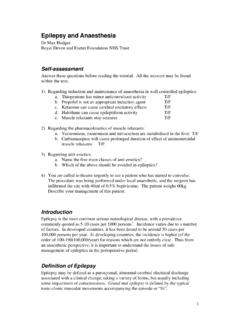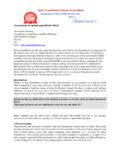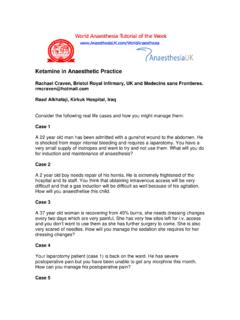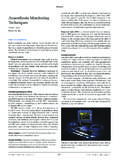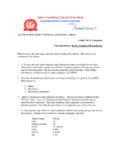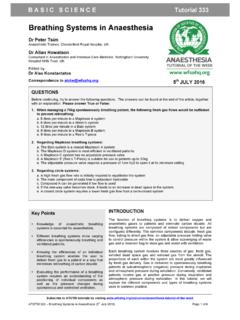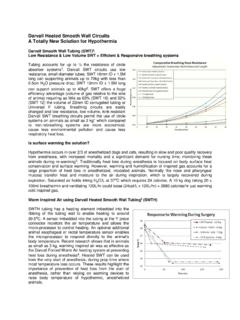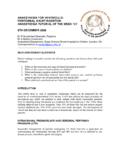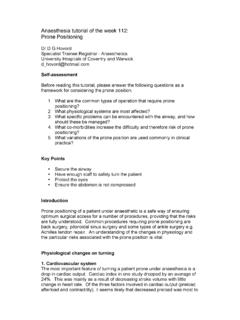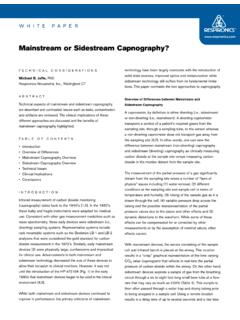Transcription of PAEDIATRIC ANATOMY AND PHYSIOLOGY AND THE ... - …
1 PAEDIATRIC ANATOMY AND PHYSIOLOGY AND THE. BASICS OF PAEDIATRIC anaesthesia . Fiona Macfarlane Mater Children's Hospital, Brisbane Australia Children are not small adults. PAEDIATRIC patients vary considerably and include the following groups: Neonates a baby within 44 weeks of age from the date of conception Infants a child of up to 12 months of age Child 1 to 12 years Adolescent 13 to 16 years The differences between PAEDIATRIC and adult anaesthetic practice are reduced as the patients become older. The important anatomical and physiological differences will be considered below followed by a discussion of how these will affect anaesthetic practice. a. Airway and Respiratory System They have a large head, short neck and a prominent occiput. The tongue is relatively large. The larynx is high and anterior, at the level of C3 - C4.
2 The epiglottis is long, stiff and U-shaped. It flops posteriorly. The sniffing the morning air' position will not help bag mask ventilation or to visualise the glottis. The head needs to be in a neutral position. Neonates preferentially breathe through their nose. Their narrow nasal passages are easily blocked by secretions and may be damaged by a nasogastric tube or a nasally placed endotracheal tube. 50% of airway resistance is from the nasal passages. The airway is funnel shaped and narrowest at the level of the cricoid cartilage. Here, the epithelium is loosely bound to the underlying tissue. Trauma to the airway easily results in oedema. One millimetre of oedema can narrow a baby's airway by 60%. (Resistance 1/radius). It is suggested that a leak be present around the endotracheal tube to prevent trauma resulting in subglottic oedema and subsequent post-extubation stridor.
3 An endotracheal tube must be inserted to the correct length to sit at least 1cm above the carina and be taped securely so as to prevent tube dislodgement with head movement, or an endobronchial intubation. The neonate and infant have limited respiratory reserve. Horizontal ribs prevent the bucket handle' action seen in adult breathing and limit an increase in tidal volume. Ventilation is primarily diaphragmatic. Bulky abdominal organs or a stomach filled with gases from poor bag mask ventilation can impinge on the contents of the chest and splint the diaphragm, reducing the ability to ventilate adequately. The chest wall is significantly more compliant than that of an adult. Subsequently, the functional residual capacity (FRC) is relatively low. FRC decreases with apnoea and anaesthesia causing lung collapse.
4 Minute ventilation is rate dependant as there is little means to increase tidal volume. The closing volume is larger than the FRC until 6-8 years of age. This causes an increased tendency for airway closure at end expiration. Thus, neonates and infants generally need IPPV during anaesthesia and would benefit from a higher respiratory rate and the use of PEEP. CPAP during spontaneous ventilation improves oxygenation and decreases the work of breathing. Work of respiration may be 15% of oxygen consumption. Muscles of ventilation are easily subject to fatigue due to low percentage of Type I. muscle fibres in the diaphragm. This number increases to the adult level over the first year of life. The alveoli are thick walled at birth. There is only 10% of the total number of alveoli found in adults.
5 The alveoli clusters develop over the first 8 years of life. Apnoeas are common post operatively in premature infants. Apnoeas are significant if they last longer than 15 seconds and are associated with desaturation or bradycardia. Caffeine 10-20 mg/kg oral or IV given peri-operatively may be useful. RR = 24 age/2. Spontaneous ventilation TV = 6-8 ml/kg; IPPV TV = 7-10ml/kg Physiological dead space = 30% and is increased by anaesthetic equipment. b. Cardiovascular System In neonates the myocardium is less contractile causing the ventricles to be less compliant and less able to generate tension during contraction. This limits the size of the stroke volume. Cardiac output is therefore rate dependent. The infant behaves as with a fixed cardiac output state. Vagal parasympathetic tone is the most dominant, which makes neonates and infants more prone to bradycardias.
6 Bradycardia is associated with reduced cardiac output. Bradycardia associated with hypoxia should be treated with oxygen and ventilation initially. External cardiac compression will be required in the neonate with a heart rate of 60 beats per minute or less, or 60-80 beats per minute with adequate ventilation. Cardiac output is 300-400 ml/kg/min at birth and 200 ml/kg/min within a few months. Sinus arrhythmia is common in children and all other irregular rhythms are abnormal. Normal Heart Rates (beats/min) and Systolic Blood Pressure (mmHg). Age Average Range ____Mean SBP_____. Preterm 130 120-170 40-55. New-born 120 100-170 50-90. 1-11 months 120 80-160 85-105. 2 years 110 80-130 95-105. 4 years 100 80-120 95-110. 6 years 100 75-115 95-110. 8 years 90 70-110 95-110. 10 years 90 70-110 100-120.
7 14 years boy 80 60-100 110-130. girl 85 65-105 110-130. 16 years boy 75 55-95 110-130. girl 80 60-100 110-130. The patent ductus contracts in the first few days of life and will fibrose within 2-4. weeks. Closure of the foramen ovale is pressure dependent and closes in the first day of life but it may reopen within the next 5 years. The neonatal pulmonary vasculature reacts to the rise in Pa02 and pH and the fall in PaCO2 at birth. However, with alterations in pressure and in response to hypoxia and acidosis, reversion to the transitional circulation may occur in the first few weeks after birth. Normal Blood Volumes Age Blood Volume _____. New-born 85 90 ml/kg 6 weeks to 2 yrs 85 ml/kg 2 yrs to puberty 80 ml/kg c. Renal System Renal blood flow and glomerular filtration are low in the first 2 years of life due to high renal vascular resistance.
8 Tubular function is immature until 8months, so infants are unable to excrete a large sodium load. Dehydration is poorly tolerated. Premature infants have increased insensible losses as that have a large surface area large surface area relative to weight. There is a larger proportion of extra cellular fluid in children (40% body weight as compared to 20%. in the adult). Urine output 1-2 ml/kg/hr d. Hepatic System Liver function is initially immature with decreased function of hepatic enzymes. Barbiturates and opioids for example have a longer duration of action due to the slower metabolism. e. Glucose Metabolism Hypoglycaemia is common in the stressed neonate and glucose levels should be monitored regularly. Glycogen stores are located in the liver and myocardium. Neurological damage may result from hypoglycaemia so an infusion of 10% glucose may be used to prevent this.
9 Infants and older children maintain blood glucose better and rarely need glucose infusions. Hyperglycaemia is usually iatrogenic f. Haematology At birth, 70-90% of the haemoglobin molecules are HbF. Within 3 months the levels of HbF drop to around 5% and HbA predominates. A haemoglobin level in a newborn will be around 18-20 g/dl which is a haematocrit of about The haemoglobin levels drop over 3-6 months to 9-12 g/dl as the increase in circulating volume increases more rapidly the bone marrow function. HbF combines more readily with oxygen but is then released less readily as there is less 2,3-DPG. HbF is protective against red cell sickling. The 02/Hb dissociation curve shifts to the right as levels of HbA and 2,3-DPG rise. The vitamin K dependent clotting factors (II, VII, IX, X) and platelet function are deficient in the first few months.
10 Vitamin K is given at birth to prevent haemorrhagic disease of the newborn. Transfusion is generally recommended when 15% of the circulating blood volume has been lost. g. Temperature Control Babies and infants have a large surface area to weight ratio with minimal subcutaneous fat. They have poorly developed shivering, sweating and vasoconstriction mechanisms. Brown fat (located in small amounts around the scapulae, the mediastinum, the kidneys and adrenal glands) metabolism is required for non-shivering thermogenesis. It comprises 2-6% of neonatal body weight. More oxygen is required for the metabolism of these brown fat stores. Heat lost during anaesthesia is mostly via radiation but may also be lost by conduction, convection and evaporation. The optimal ambient temperature to prevent heat loss is 34 C for the premature infant, 32 C for neonates and 28 C in adolescents and adults.
